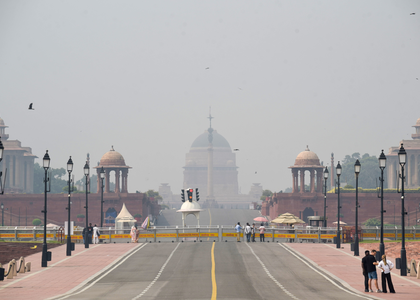GRAP Stage-II curbs imposed as air quality plummets to 'very poor' in Delhi
By IANS | Updated: October 19, 2025 23:30 IST2025-10-19T23:29:49+5:302025-10-19T23:30:20+5:30
New Delhi, Oct 19 Delhi’s air quality crisis deepened, prompting the Commission for Air Quality Management (CAQM) in ...

GRAP Stage-II curbs imposed as air quality plummets to 'very poor' in Delhi
New Delhi, Oct 19 Delhi’s air quality crisis deepened, prompting the Commission for Air Quality Management (CAQM) in the National Capital Region (NCR) and adjoining areas to swiftly activate Stage-II of the Graded Response Action Plan (GRAP).
The city’s daily average Air Quality Index (AQI) climbed to 296 ('Poor') by the Central Pollution Control Board (CPCB), surging to 300 by 6 p.m. and hitting 302 by 7 p.m., nudging it into the 'Very Poor' category.
This alarming trend triggered an urgent meeting of the CAQM’s GRAP Sub-Committee, which reviewed forecasts from the India Meteorological Department (IMD) and Indian Institute of Tropical Meteorology (IITM), predicting sustained 'Very Poor' conditions (301-400) in the days ahead due to localised emissions, stagnant winds, and temperature inversions.
In a decisive move to curb the worsening pollution, the Sub-Committee unanimously rolled out a 12-point action plan under Stage-II, building on existing Stage-I measures. Agencies like the Pollution Control Boards of NCR states and the Delhi Pollution Control Committee (DPCC) have been tasked with rigorous enforcement. The plan kicks off with daily mechanical sweeping and water sprinkling on key roads, ramping up machinery shifts, and dusting hotspots and traffic corridors with suppressants before peak hours, ensuring proper waste disposal.
Stricter checks on construction sites, targeted hotspot interventions, and uninterrupted power supply to limit diesel generator (DG) use are also in play. DG operations are restricted to emergencies—hospitals, railways, Metros, airports, sewage plants, water pumps, national security projects, and telecom— as per the direction issued on September 29, 2023. Traffic flow will be smoothed with personnel at congestion points, while media will broadcast pollution alerts and guidelines.
Higher parking fees aim to deter private vehicles, and public transport—bolstered by additional CNG/electric buses and Metro services with off-peak incentives—will see a boost. Resident Welfare Associations must provide electric heaters to staff to prevent biomass burning, and only electric, CNG, or BS-VI diesel inter-state buses can enter Delhi.
CAQM urges citizens to embrace public transport, avoid dusty construction, and shun waste burning, aligning with the Citizen Charter for Stages I and II.
With the situation under close watch and regular reviews planned, the full GRAP details are online at CAQM’s website. This escalation, driven by stubble burning and vehicular emissions, underscores the urgent need for regional cooperation to tackle the winter smog.
Disclaimer: This post has been auto-published from an agency feed without any modifications to the text and has not been reviewed by an editor
Open in app